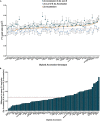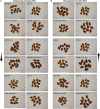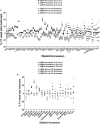Parent-of-Origin Effects on Seed Size Modify Heterosis Responses in Arabidopsis thaliana
- PMID: 35330872
- PMCID: PMC8940307
- DOI: 10.3389/fpls.2022.835219
Parent-of-Origin Effects on Seed Size Modify Heterosis Responses in Arabidopsis thaliana
Abstract
Parent-of-origin effects arise when a phenotype depends on whether it is inherited maternally or paternally. Parent-of-origin effects can exert a strong influence on F1 seed size in flowering plants, an important agronomic and life-history trait that can contribute to biomass heterosis. Here we investigate the natural variation in the relative contributions of the maternal and paternal genomes to F1 seed size across 71 reciprocal pairs of F1 hybrid diploids and the parental effect on F1 seed size heterosis. We demonstrate that the paternally derived genome influences F1 seed size more significantly than previously appreciated. We further demonstrate (by disruption of parental genome dosage balance in F1 triploid seeds) that hybridity acts as an enhancer of genome dosage effects on F1 seed size, beyond that observed from hybridity or genome dosage effects on their own. Our findings indicate that interactions between genetic hybridity and parental genome dosage can enhance heterosis effects in plants, opening new avenues for boosting heterosis breeding in crop plants.
Keywords: Arabidopsis; Parent-of-origin effects; heterosis; hybridity; parental genome dosage; paternal contribution; ploidy; seed size.
Copyright © 2022 Castillo-Bravo, Fort, Cashell, Brychkova, McKeown and Spillane.
Conflict of interest statement
The authors declare that the research was conducted in the absence of any commercial or financial relationships that could be construed as a potential conflict of interest.
Figures





Similar articles
-
Disaggregating polyploidy, parental genome dosage and hybridity contributions to heterosis in Arabidopsis thaliana.New Phytol. 2016 Jan;209(2):590-9. doi: 10.1111/nph.13650. Epub 2015 Sep 23. New Phytol. 2016. PMID: 26395035
-
Hybridity has a greater effect than paternal genome dosage on heterosis in sugar beet (Beta vulgaris).BMC Plant Biol. 2018 Jun 15;18(1):120. doi: 10.1186/s12870-018-1338-x. BMC Plant Biol. 2018. PMID: 29907096 Free PMC article.
-
Parental-genome dosage effects on the transcriptome of F1 hybrid triploid embryos of Arabidopsis thaliana.Plant J. 2017 Dec;92(6):1044-1058. doi: 10.1111/tpj.13740. Epub 2017 Nov 28. Plant J. 2017. PMID: 29024088
-
One Hundred Years of Progress and Pitfalls: Maximising Heterosis through Increasing Multi-Locus Nuclear Heterozygosity.Biology (Basel). 2024 Oct 12;13(10):817. doi: 10.3390/biology13100817. Biology (Basel). 2024. PMID: 39452126 Free PMC article. Review.
-
Recent research on the mechanism of heterosis is important for crop and vegetable breeding systems.Breed Sci. 2018 Mar;68(2):145-158. doi: 10.1270/jsbbs.17155. Epub 2018 Apr 12. Breed Sci. 2018. PMID: 29875598 Free PMC article. Review.
Cited by
-
Unveiling the imprinted dance: how parental genomes orchestrate seed development and hybrid success.Front Plant Sci. 2024 Sep 27;15:1455685. doi: 10.3389/fpls.2024.1455685. eCollection 2024. Front Plant Sci. 2024. PMID: 39399543 Free PMC article. Review.
-
Morphological and metabolomics profiling of intraspecific Arabidopsis hybrids in relation to biomass heterosis.Sci Rep. 2023 Jun 12;13(1):9529. doi: 10.1038/s41598-023-36618-y. Sci Rep. 2023. PMID: 37308530 Free PMC article.
-
The CsPPR gene with RNA-editing function involved in leaf color asymmetry of the reciprocal hybrids derived from Cucumis sativus and C. hystrix.Planta. 2024 Sep 20;260(4):102. doi: 10.1007/s00425-024-04513-z. Planta. 2024. PMID: 39302471
-
Transgressive and parental dominant gene expression and cytosine methylation during seed development in Brassica napus hybrids.Theor Appl Genet. 2023 Apr 18;136(5):113. doi: 10.1007/s00122-023-04345-7. Theor Appl Genet. 2023. PMID: 37071201 Free PMC article.
-
Improving Yield and Yield Stability in Winter Rye by Hybrid Breeding.Plants (Basel). 2022 Oct 10;11(19):2666. doi: 10.3390/plants11192666. Plants (Basel). 2022. PMID: 36235531 Free PMC article. Review.
References
-
- Abbott R., Albach D., Ansell S., Arntzen J. W., Baird S. J., Bierne N., et al. (2013). Hybridization and speciation. J. Evol. Biol. 26 229–246. - PubMed
-
- Abramoff M. D., Magalhaes P. J., Ram S. J. (2004). Image processing with imageJ. Biophoton. Int. 11 36–42.
-
- Armenta-Medina A., Gillmor C. S. (2019). “Chapter Eighteen - Genetic, molecular and parent-of-origin regulation of early embryogenesis in flowering plants,” in Current Topics in Developmental Biology, ed. Grossniklaus U. (Cambridge: Academic Press; ), 497–543. 10.1016/bs.ctdb.2018.11.008 - DOI - PubMed
LinkOut - more resources
Full Text Sources

